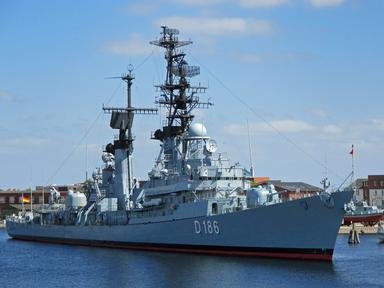Quiz Answer Key and Fun Facts
1. In 1906, work began on a class of three of a new type of ship for the Royal Navy. Which of these was NOT one of the first class of battlecruiser?
2. Germany's response to what it thought was the Royal Navy's new cruisers, SMS 'Blücher', was found to be outclassed even before being laid down. As a result, the Imperial German Navy was forced to design a new ship that would be a match for the British ships. What was it called?
3. In the first decade of the 20th century, Britain's overseas dominions were tasked with making a greater contribution to the Empire's naval defences through the formation of so-called "fleet units", with a battlecruiser as its flagship. Which dominion was the first to procure such a fleet unit?
4. The first surface confrontation of the First World War saw the Royal Navy's Mediterranean Fleet pursue the Imperial German Navy's two ship Mediterranean Division. Which battlecruiser served as the German flagship?
5. In 1911, the Vickers shipyard at Barrow-in-Furness began construction of the first of a class of four battlecruisers for the Imperial Japanese Navy. Giving its name to the class, what was this ship called?
6. The design of the new battlecruisers for Japan led to a rethink for the Royal Navy, as the Japanese ships were superior to the battlecruisers then under construction for Britain. As a result, a new battlecruiser design was conceived to match the Japanese ships. What was the first ship of this design called?
7. At the Battle of Jutland in May 1916, the Royal Navy saw three of its battlecruisers destroyed. Which one did NOT end up at the bottom of the North Sea?
8. After the end of the First World War, the United States Navy began constructing a class of six battlecruisers, which would have been the first of their type in US service. This class was eventually cancelled by the 1922 Washington Naval Conference, but the US was permitted to convert two into aircraft carriers. The lead ship, USS 'Lexington' was one, but which was the other?
9. In 1944, the US Navy commissioned the first of a class of so-called "large cruisers", which were equivalent in design and scope to a battlecruiser. What was the name of this ship, and thus the class that followed?
10. In the mid 1970s, the Soviet Navy introduced a revolutionary new type of large, nuclear powered missile cruiser, larger than any surface ship type other than aircraft carriers commissioned since the end of the Second World War, and referred to in the West as a 'battlecruiser'. Renamed as 'Admiral Ushakov' following the dissolution of the Soviet Union, what was the ship originally called?
Source: Author
Red_John
This quiz was reviewed by FunTrivia editor
stedman before going online.
Any errors found in FunTrivia content are routinely corrected through our feedback system.
